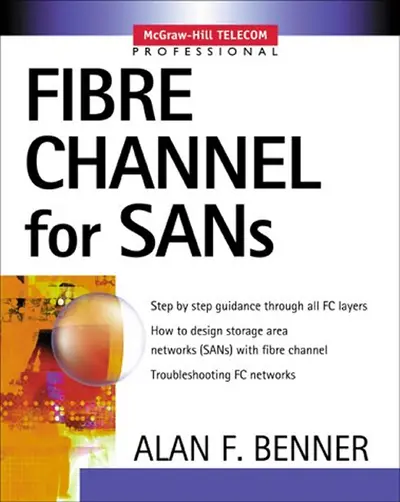My Account Details

ISBN10: 0071500626 | ISBN13: 9780071500623

Introduction. Chapter 1: Fibre Channel Structure and Concepts. Chapter 2: Storage Area Networks. Chapter 3: Mass Storage. Chapter 4: Example: System Initialization and Data Transfer. Chapter 5: FC-0: Physical Interface. Chapter 6: FC-1: 8B/10B Transmission code, Transmitters, and Receivers. Chapter 7: Ordered Sets, Port States, and Primitive Sequence Protocols. Chapter 8: FC-2: Frames. Chapter 9: FC-2: Sequences and Exchanges. Chapter 10: Login and Logout Services. Chapter 11: Classes of Service. Chapter 12: Link Services. Chapter 13: Error Detection and Recovery. Chapter 14: Association Management and Other Optional Headers. Chapter 15: Class 1 Connection Management. Chapter 16: Flow Control. Chapter 17: FC-AL: Arbitrated Loop Architecture and Operations. Chapter 18: FC-4: Mapping IP and SCSI over Fibre Channel.
Chapter 2: Storage Area Networks. Chapter 3: Mass Storage. Chapter 4: Example: System Initialization and Data Transfer. Chapter 5: FC-0: Physical Interface. Chapter 6: FC-1: 8B/10B Transmission code, Transmitters, and Receivers. Chapter 7: Ordered Sets, Port States, and Primitive Sequence Protocols. Chapter 8: FC-2: Frames. Chapter 9: FC-2: Sequences and Exchanges. Chapter 10: Login and Logout Services. Chapter 11: Classes of Service. Chapter 12: Link Services. Chapter 13: Error Detection and Recovery. Chapter 14: Association Management and Other Optional Headers. Chapter 15: Class 1 Connection Management. Chapter 16: Flow Control. Chapter 17: FC-AL: Arbitrated Loop Architecture and Operations. Chapter 18: FC-4: Mapping IP and SCSI over Fibre Channel.
Chapter 4: Example: System Initialization and Data Transfer. Chapter 5: FC-0: Physical Interface. Chapter 6: FC-1: 8B/10B Transmission code, Transmitters, and Receivers. Chapter 7: Ordered Sets, Port States, and Primitive Sequence Protocols. Chapter 8: FC-2: Frames. Chapter 9: FC-2: Sequences and Exchanges. Chapter 10: Login and Logout Services. Chapter 11: Classes of Service. Chapter 12: Link Services. Chapter 13: Error Detection and Recovery. Chapter 14: Association Management and Other Optional Headers. Chapter 15: Class 1 Connection Management. Chapter 16: Flow Control. Chapter 17: FC-AL: Arbitrated Loop Architecture and Operations. Chapter 18: FC-4: Mapping IP and SCSI over Fibre Channel.
Chapter 6: FC-1: 8B/10B Transmission code, Transmitters, and Receivers. Chapter 7: Ordered Sets, Port States, and Primitive Sequence Protocols. Chapter 8: FC-2: Frames. Chapter 9: FC-2: Sequences and Exchanges. Chapter 10: Login and Logout Services. Chapter 11: Classes of Service. Chapter 12: Link Services. Chapter 13: Error Detection and Recovery. Chapter 14: Association Management and Other Optional Headers. Chapter 15: Class 1 Connection Management. Chapter 16: Flow Control. Chapter 17: FC-AL: Arbitrated Loop Architecture and Operations. Chapter 18: FC-4: Mapping IP and SCSI over Fibre Channel.
Chapter 8: FC-2: Frames. Chapter 9: FC-2: Sequences and Exchanges. Chapter 10: Login and Logout Services. Chapter 11: Classes of Service. Chapter 12: Link Services. Chapter 13: Error Detection and Recovery. Chapter 14: Association Management and Other Optional Headers. Chapter 15: Class 1 Connection Management. Chapter 16: Flow Control. Chapter 17: FC-AL: Arbitrated Loop Architecture and Operations. Chapter 18: FC-4: Mapping IP and SCSI over Fibre Channel.
Chapter 10: Login and Logout Services. Chapter 11: Classes of Service. Chapter 12: Link Services. Chapter 13: Error Detection and Recovery. Chapter 14: Association Management and Other Optional Headers. Chapter 15: Class 1 Connection Management. Chapter 16: Flow Control. Chapter 17: FC-AL: Arbitrated Loop Architecture and Operations. Chapter 18: FC-4: Mapping IP and SCSI over Fibre Channel.
Chapter 12: Link Services. Chapter 13: Error Detection and Recovery. Chapter 14: Association Management and Other Optional Headers. Chapter 15: Class 1 Connection Management. Chapter 16: Flow Control. Chapter 17: FC-AL: Arbitrated Loop Architecture and Operations. Chapter 18: FC-4: Mapping IP and SCSI over Fibre Channel.
Chapter 14: Association Management and Other Optional Headers. Chapter 15: Class 1 Connection Management. Chapter 16: Flow Control. Chapter 17: FC-AL: Arbitrated Loop Architecture and Operations. Chapter 18: FC-4: Mapping IP and SCSI over Fibre Channel.
Chapter 16: Flow Control. Chapter 17: FC-AL: Arbitrated Loop Architecture and Operations. Chapter 18: FC-4: Mapping IP and SCSI over Fibre Channel.
Chapter 18: FC-4: Mapping IP and SCSI over Fibre Channel.
Need support? We're here to help - Get real-world support and resources every step of the way.